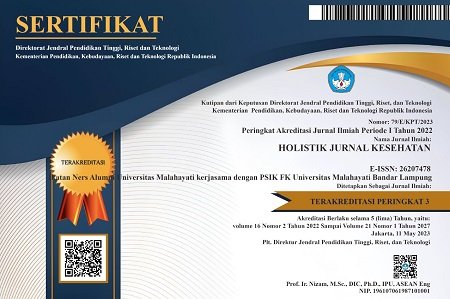Efektivitas low fidelity simulation terhadap self-efficacy mahasiswa keperawatan dalam melakukan bantuan hidup dasar
Abstract
Effectiveness of low fidelity simulation toward nursing students’ self-efficacy in doing basic life support
Background: The use of simulation as learning method has proven to improved student’s self-efficacy and competency. Various simulators has been developed to achieve these objectives, ranging from low, medium, to high-fidelity simulators. Among others, low-fidelity simulator has the lowest cost with the same effectiveness as other simulators.
Purpose: To examine the effectiveness of low-fidelity simulation in increasing nursing students’ self-efficacy in performing Basic Life Support (BLS) skill.
Method: A quasi-experimental method with non-equivalent pretest - posttest design was used to answer research questions. One chest manikin for Cardio Pulmonary Resuscitation (CPR) was used as a low-fidelity simulator in practicing BLS skill. 47 students were recruited as respondents using a purposive sampling method with students who undergoing emergency nursing course and agreed to participate in the study as inclusions criteria. Furthermore, without randomization, 23 respondents were included in the control group and 24 respondents in the intervention group. The effect of low fidelity simulation on students' self-efficacy was measured using the Basic Resuscitation Scale Self-Efficacy Scale (BRS-SES) questionnaire consisting of 18 items with responses option ranging from 1 = not confident, 2 = somewhat confident, 3 = confident, 4 = very confident, and 5 = very very confident. Questionnaire were given to respondents before and after the intervention. The collected data were analyzed using Analysis of Covariance (ANCOVA).
Results: The mean score of students’ self-efficacy before intervention was 38.89 (SD = 10.149), and after intervention was 47.17 (SD = 13.099). There was no significant difference in self-efficacy mean score between the control group and the intervention group (F = 0.625, p> 0.05). So, it can be concluded that the use of low-fidelity simulation method did not have a significant effect in increasing nursing students’ self-efficacy.
Conclusions: Although the use of low-fidelity simulation method does not have a significant effect in increasing nursing students’ self-efficacy, this method can be used as an effective learning method to improve nursing students’ skills and competencies.
Keywords: Low fidelity simulation; Nursing student; Self-efficacy; Simulation.
Pendahuluan: Penggunaan simulasi sebagai metode pengajaran dapat meningkatkan self-efficacy dan performa kompetensi siswa perawat. Beragam simulator dikembangkan untuk mencapai tujuan tersebut, mulai dari low, medium, hingga high-fidelity simulator.Diantara ketiganya, low-fidelity simulator merupakan simulator yang paling rendah dari segi pembiayaan, namun secara efektivitas sama dengan simulator lainnya.
Tujuan: Mengetahui efektivitas metode low-fidelity simulation terhadap self-efficacy mahasiswa keperawatan dalam melakukan keterampilan Bantuan Hidup Dasar (BHD).
Metode: Quasi eksperimen dengan non-equivalent pretest -posttest design digunakan untuk menjawab pertanyaan penelitian. Satu manikin dada untuk Resusitasi Jantung Paru (RJP) digunakan sebagai low fidelity simulator dalam pelaksanaan simulasi BHD. 47 mahasiswa direkrut sebagai responden menggunakan metode purposive sampling dengan kriteria inklusi mahasiswa yang sedang mengikuti mata kuliah keperawatan gawat darurat dan setuju untuk berpartisipasi dalam penelitian. Selanjutnya, tanpa randomisasi, 23 responden dimasukkan dalam grup kontrol dan 24 responden dalam grup intervensi. Pengaruh low fidelity simulation terhadap self-efficacy mahasiswa diukur menggunakan kuisioner Basic Resuscitation Skills Self-Efficacy Scale (BRS-SES) yang terdiri dari 18 butir pernyataan dengan rentang jawaban 1 = tidak percaya diri, 2 = agak percaya diri, 3 = percaya diri, 4 = sangat percaya diri, dan 5 = sangat sangat percaya diri. Kuisioner diberikan kepada responden sebelum dan sesudah intervensi. Data yang terkumpul selanjutnya dianalisis menggunakan Analysis of Covariance (ANCOVA).
Hasil: Mean skor self-efficacy mahasiswa keperawatan sebelum intervensi adalah 38.89 (SD=10.149), dan setelah intervensi adalah 47.17 (SD=13.099). Tidak terdapat perbedaan mean yang signifikan antara skor self-efficacy kelompok kontrol dan kelompok intervensi (F= 0.625, p>0.05). Dapat disimpulkan bahwa penggunaan metode low fidelity simulation tidak memiliki pengaruh signifikan terhadap peningkatan self-efficacy mahasiswa keperawatan.
Simpulan: Meskipun penggunaan metode low fidelity simulation tidak memiliki pengaruh yang signifikan terhadap peningkatan self-efficacy mahasiswa keperawatan, namun metode ini dapat digunakan sebagai metode pembelajaran yang efektif untuk meningkatkan keterampilan dan kompetensi mahasiswa keperawatan.
Keywords
References
American Heart Association. (2015). BLS Healthcare Provider Adult Cardiac Arrest Algorithm—2015 Update. (Online). Di unduh dari https://eccguidelines.heart.org/index.php/circulation/cpr-ecc-guidelines-2/part-5-adult-basic-life-support-and-cardiopulmonary-resuscitation-quality/.
Çelik, Y., Ceylantekin, Y., & Kiliç, İ. (2017). The evaluation of simulation maket in nursing education and the determination of learning style of students. International journal of health sciences, 11(3), 74.
Chen, R., Grierson, L. E., & Norman, G. R. (2015). Evaluating the impact of high‐and low‐fidelity instruction in the development of auscultation skills. Medical education, 49(3), 276-285.
Dearmon, V., Graves, R. J., Hayden, S., Mulekar, M. S., Lawrence, S. M., Jones, L., & Farmer, J. E. (2012). Effectiveness of simulation-based orientation of baccalaureate nursing students preparing for their first clinical experience. Journal of Nursing Education, 52(1), 29-38.
Dunn, K. E., Osborne, C., & Link, H. J. (2014). Research Briefs High-Fidelity Simulation and Nursing Student Self-Efficacy: Does Training Help the Little Engines Know They Can?. Nursing Education Perspectives, 35(6), 403-404.
Endacott, R., Bogossian, F. E., Cooper, S. J., Forbes, H., Kain, V. J., Young, S. C., & First2Act Team. (2015). Leadership and teamwork in medical emergencies: performance of nursing students and registered nurses in simulated patient scenarios. Journal of clinical nursing, 24(1-2), 90-100.
Fatih, H., & Rahmidar, L. (2019). Kepuasan dan Kepercayaan Diri Mahasiswa Keperawatan Terhadap Penggunaan Low Fidelity Simulator Dalam Simulasi Bantuan Hidup Dasar. Jurnal Keperawatan BSI, 7(2).
Findik, Ü. Y., Yeşilyurt, D. S., & Makal, E. (2019). Determining student nurses’ opinions of the low-fidelity simulation method. Nursing Practice Today.
Foronda, C., Liu, S., & Bauman, E. B. (2013). Evaluation of simulation in undergraduate nurse education: An integrative review. Clinical simulation in nursing, 9(10), e409-e416.
Franklin, A. E., & Lee, C. S. (2014). Effectiveness of simulation for improvement in self-efficacy among novice nurses: A meta-analysis. Journal of Nursing Education, 53(11), 607-614.
Gosselin, A. M. (2013). Nursing simulation experience: self-efficacy, state anxiety, locus of control, and simulation effectiveness.
Hernández-Padilla, J., Suthers, F., Fernández-Sola, C., & Granero-Molina, J. (2016). Development and psychometric assessment of the basic resuscitation skills self-efficacy scale. European Journal of Cardiovascular Nursing, 15(3), e10-e18.
Houghton, C. E. (2014). ‘Newcomer adaptation’: a lens through which to understand how nursing students fit in with the real world of practice. Journal of clinical nursing, 23(15-16), 2367-2375.
Kowitlawakul, Y., Chow, Y. L., Salam, Z. H. A., & Ignacio, J. (2015). Exploring the use of standardized patients for simulation-based learning in preparing advanced practice nurses. Nurse education today, 35(7), 894-899.
Lin, H. H. (2016). Effectiveness of simulation-based learning on student nurses' self-efficacy and performance while learning fundamental nursing skills. Technology and Health Care, 24(s1), S369-S375.
Martins, J. C. A., Mazzo, A., Baptista, R. C. N., Coutinho, V. R. D., Godoy, S. D., Mendes, I. A. C., & Trevizan, M. A. (2012). The simulated clinical experience in nursing education: a historical review. Acta Paulista de Enfermagem, 25(4), 619-625.
Mould, J., White, H., & Gallagher, R. (2011). Evaluation of a critical care simulation series for undergraduate nursing students. Contemporary Nurse, 38(1-2), 180-190.
Saied, H. (2017). The Impact of Simulation on Pediatric Nursing Students' Knowledge, Self-Efficacy, Satisfaction, and Confidence. Journal of Education and Practice, 8(11), 95-102.
Scully, N. J. (2011). The theory-practice gap and skill acquisition: An issue for nursing education. Collegian, 18(2), 93-98
Shin, S., Park, J. H., & Kim, J. H. (2015). Effectiveness of patient simulation in nursing education: meta-analysis. Nurse education today, 35(1), 176-182.
Tobase, L., Peres, H. H., Gianotto-Oliveira, R., Smith, N., Polastri, T. F., & Timerman, S. (2017). The effects of an online basic life support course on undergraduate nursing students’ learning. International journal of medical education, 8, 309.
Tynjälä, P., & Gijbels, D. (2012). Changing world: Changing pedagogy. In Transitions and transformations in learning and education (pp. 205-222). Springer, Dordrecht.
Xiaoying, M. (2013). BSN Students’ Perception of Satisfactio and Self-confidence After a Simulated Mock Code Experience: A Descriptive Study. Califórnia (EUA): Cedarville University.
DOI: https://doi.org/10.33024/hjk.v14i4.3159
Refbacks
- There are currently no refbacks.
Copyright (c) 2020 Holistik Jurnal Kesehatan

This work is licensed under a Creative Commons Attribution-NonCommercial 4.0 International License.














